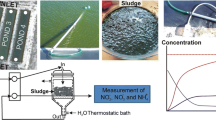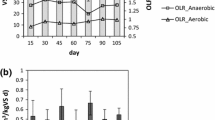Abstract
The inhibitory effect of Ni upon a biological system of activated sludge has been analyzed in two semicontinuous sequential reactors feeding synthetic wastewater. One of the reactors was used as control while in the other given amounts of NiSO4 were added to the influent to achieve a concentration of 30 ppm Ni(II). An analysis of the characteristic biokinetic parameters has been made and the correspondence with the operating conditions stated. A series of O2 uptake tests were proposed and the results analyzed together with the specific rate of substrate removal (U) in order to explain the toxic influence of Ni(II). An accumulation of undigested substrate on the floes seems to explain certain aspects derived of the presence of Ni. The sludge residence time (SRT), within a certain range, can be used as a control operating variable to mitigate the inhibitory effect of Ni, since a somewhat contrary effect upon the settling characteristics of the sludge must be also considered.
Similar content being viewed by others
Abbreviations
- C0 :
-
Initial concentration of oxygen, mg L−1
- C:
-
oxygen concentration at time t, mg L−1
- k :
-
Kinetic constant of substrate disappearance, d−1
- k d :
-
Kinetic constant of biomass disappearance, d−1
- K s :
-
Substrate concentration defined in Equation (7), mg L−1
- k u :
-
Kinetic constant of oxygen consumption, hr−1
- N :
-
Number of cycles a day in the reactor, d−1
- Q :
-
Flow rate, L d−1
- r s :
-
Rate of substrate disappearance, d−1
- r b :
-
Rate of biomass growth, d−1
- S e, S 0 :
-
Substrate concentrations, in the effluent and initially in the reactor as COD, L−1
- t :
-
Time, d or hr
- t h :
-
Hydraulic residence time. t h= V/Q, hr or d
- t r :
-
Refloculation time in settling experiments, min
- t s :
-
Sludge residence time, t s = V/Q w, hr or d
- U :
-
Specific rate of substrate removal referred to COD, mg L−1 U = (S 0 − S e)/(X t h)
- U 0 :
-
Specific rate of substrate removal referred to oxygen, mg L−1
- v s :
-
Settling velocity in the constant rate period, cm min−1
- V :
-
Reactor volume or volume in general, L or mL
- V i :
-
Influent fed to the aerobic system, L
- X :
-
Biomass concentration as MLSS, mg L−1
- Y :
-
Biomass yield, mg MLSS mg−1 COD
- μ:
-
Kinetic constant of biomass growth, d−1
- V m :
-
Volume in the oxygen uptake experiments, mL
- V LM :
-
Volume of mixed liquor employed for O2 uptake experiments, mL.
- aer:
-
Aeration
- e :
-
effluent
- max:
-
maximum
- net:
-
net value
- o:
-
initial
- set:
-
settling
- w :
-
wasted
References
APHA: 1985, Standard Methods for the Examination of Water and Wastewater, 16th Ed., American Public Health Association, Washington, D.C.
Brown, M. J. and Lester, J. N.: 1982a, Water Research 16, 1539.
Brown, M. J. and Lester, J. N.: 1982b, Water Research 16, 1549.
Convery, C. C., Cohen, J. M., and Bishop, D. F.: 1980, 'Occurrence and removal of toxics in municipal wastewater treatment facilities, 7th Joint US/Japan Conference, Japan, Tokyo.
Daigger, G. and Grady, C. P. L. (Jr.): 1977, Water Res. 11, 1049.
Elenbogen, G., Sawyer, B., Lue-Hing, C., Rao, K. V., and Zenz, D. R.: 1987, ‘Studies of the uptake of heavy metals by activated sludge’, Metals Speciation Separation and Recovery, Lewis Publishers Inc., Chelsea (Mich.).
EPA.: 1976, Quality Criteria for Water, U.S. Environ. Prot. Agency, Washington D.C.
Hartz, K. E., Zane, A. T., and Bhagat, S. K.: 1985, J. Water Pollut. Con. F. 57, 942.
Hammer, M. J.: 1986, Water and Wastewater Technology, John Wiley & Sons, NY.
Lester, J. N., Harrison, R. M., and Perry, R.: 1979, Sci. Total Environ. 12, 13.
Lombraña, J. I., Varona, F., Mijangos, F., and Díaz, M.: 1989, ‘Present Situation and solutions for an Agricultural Reclamation of Residuals from the Wastewater Treatment Plants’. 5th Int. Confer. Solid Wastes, sludges and Residual Materials, Roma.
Lue-Hing, C., Lordi, D. T., and Kelada, N. P.: 1981, ‘Fate of Priority Pollutants in Large Treatment Municipal Plants’, AIChE Sym. Ser. 77, No. 209, 144.
Matsumoto, M. R. and Weber, A. S.: 1989, Chem. Eng. Comm. 86, 1.
Nelson, P. O.: 1987, ‘Studies of the uptake of heavy metals by activated sludge’, Metals Speciation, Separation and Recovery, J. W. Patterson, Lewis Publishers Inc., Chelsea (Mich.).
Poon, C. A. and Bhayani, K. H.: 1971, Proc. Am. Soc. Civil Eng. 97, 161.
Trahern, P. G., Knocke, W. R., and Sherrard, J. H.: 1985, ‘The effect of Ni(II) on nitrification in the activated sludge process’, AIChE Sym. Ser. 77 No. 209, 171.
Wiesmann, U. and Putaerglis, A.: 1986, Germ. Chem. Eng. 89, 284.
Author information
Authors and Affiliations
Rights and permissions
About this article
Cite this article
Lombraña, J.I., Varona, F. & Mijangos, F. Biokinetic behavior and settling characteristics in an activated sludge under the effect of toxic Ni(II) influentes. Water Air Soil Pollut 69, 57–68 (1993). https://doi.org/10.1007/BF00478347
Received:
Revised:
Issue Date:
DOI: https://doi.org/10.1007/BF00478347




